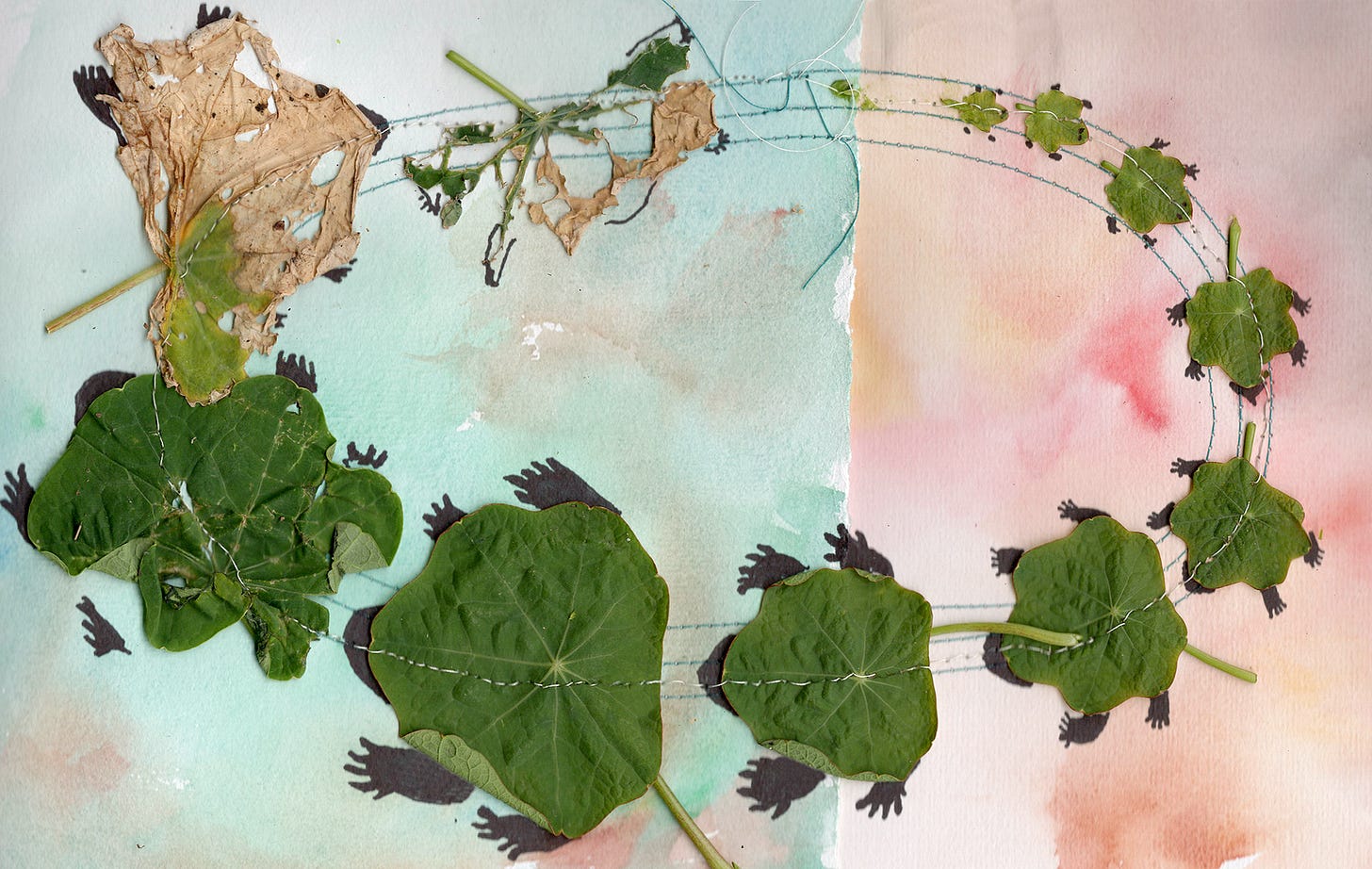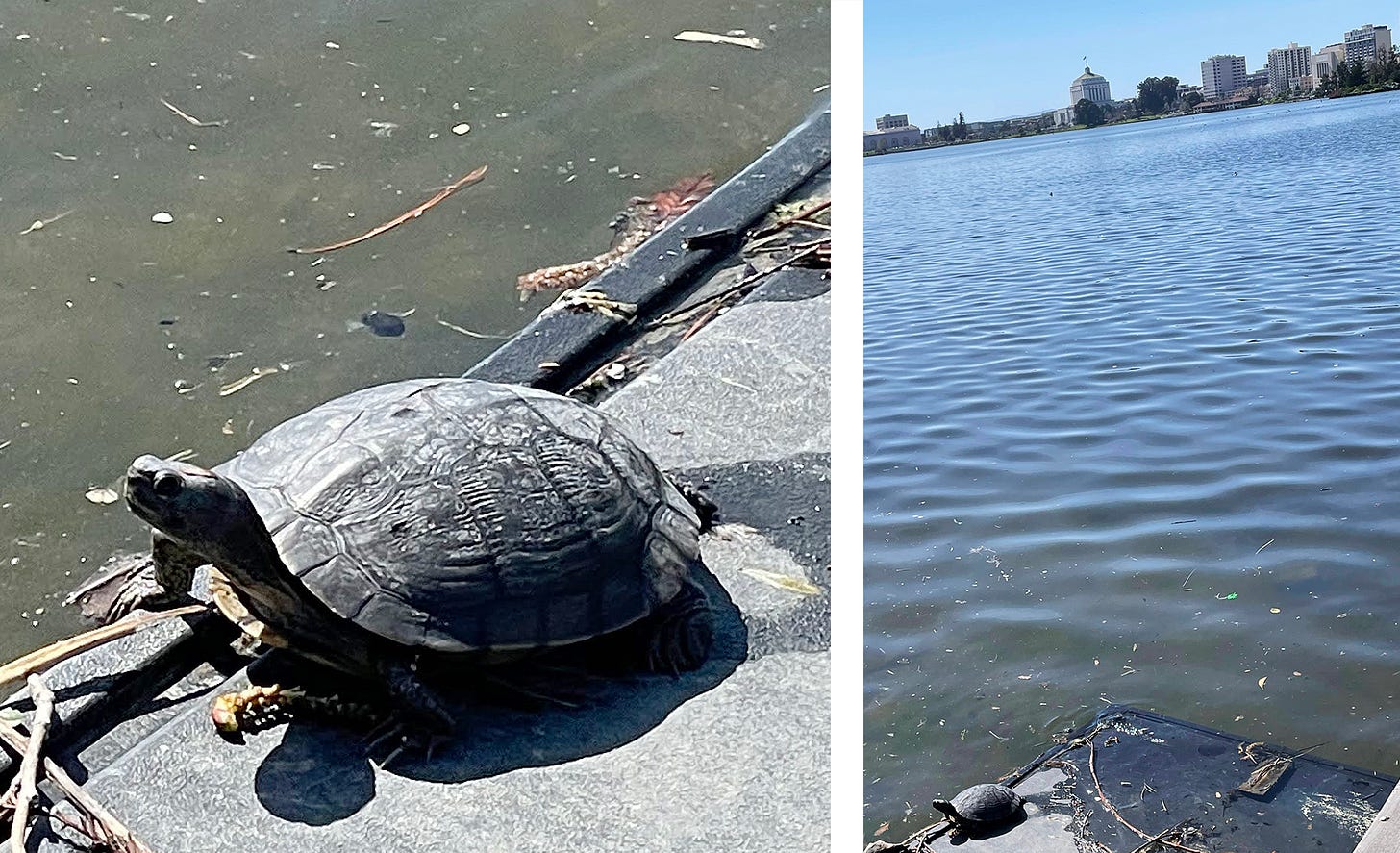Running with the Turtles
How might we work and rest together, with nature, slowly, regeneratively, nourishing people, animals, and the environment? Regenerative design as conscious slowness to resist the speed competition.
Did your spring come in like a lion or a lamb? Did your groundhog's prediction come true? We look for animals to guide us into the seasons, and on the eve of the Spring Equinox, I found myself running with the turtles.
A year ago, I ran my first 10K. Coming off the runner's high of a faster-than-anticipated finish, I vowed to spend time during my sabbatical year training for a half marathon. Yet here I am, a year later, trotting out a very slow 5k. On the eve of the Spring Equinox, I jogged around Lake Merritt (the urban lake I'm lucky to live next to), reflecting on the (half) marathon I did not run when I encountered a turtle on the side of the lake. It felt fitting for my pace but also shone in the sun like a sign calling out to me. As I jogged along, reflecting on the pace of my movements during my sabbatical, I came to peace with going slower, not faster.
Conscious Nothing
I had other (perhaps less athletic, more scholarly) sabbatical goals that also didn't happen as planned. As I ran around the lake with the turtles, I remembered a conversation I had about a year ago in preparation for my sabbatical. I contacted one of my graduate school advisors looking for advice. We talked about my career, accomplishments, and thoughts on what to do next. As I sat ready for her instructions, pen and paper in hand, ready to take down her instructions on what to do, names of people to contact, and how to maximize my time, instead, she told me, "I think you should be radically honest and do nothing. And in that nothing, something will come." I was taken back a bit. This advice felt strange coming from someone who once pushed me to work harder and deeper and all the things you are encouraged to do while in graduate school. Now, I was being told to do… nothing. I've come back to her words many times in the past year. For it wasn't just doing nothing. There's a conscious honesty, a making of space for something to come.
The following weekend, my family and I saw my daughter's cello teacher perform an experimental piece with other musicians, visual artists, and dancers. The work, titled Intertwine, explored our shared connections with nature and the environment. Taking in the exhibition afterward, I was immediately struck by the visuals of the scores, which were just as much objects in the installation, as musical notes on a page. Despite being an interactive hour-plus-long performance, the sheet music for each instrument contained simple notations on single sheets of paper. In sharing her process for composing, she explained she often thought deeply about specific themes and ideas for about a year, and then the music just happened. Her process, too, was an emergence from slowness.
Of course, a radically honest nothing is not nothing. These slow jogs with turtles, deep year-long contemplations, and conscious pauses are intentional and quite active in the smallest of actions. They should not be confused with inaction, complacency, or ignorance. There's far too much of that in this world as it is. This is not turning the other eye, remaining silent, or going on with the status quo.
Resisting with Rest
Tricia Hersey famously coined the term "rest as resistance" in her New York Times best-selling book of the same name. Hersey has described "rest as a form of radical resistance to the current culture of hyper-productivity." Our self-worth should not come from round-the-clock work and exponential outputs. Resting resists this. Resting, when truly resting (not Netflix vegging), regenerates ourselves.
Our current take-make-waste culture is built on extracting resources. We extract natural and physical resources to produce goods, but our labor is also extractive. All too often, we fall into the traps of capitalism working more, to get more, to have more, thinking we must be always on, always going. It's no wonder why burnout rates continue to rise as individuals come to terms with the unsustainable nature of extractive labor on personal levels. Resting, as a conscious nothing, in order to restore and regenerate, resists this urge and the pace around us.
When people ask me to explain regenerative design, I often use regenerative brakes in electric and hybrid cars as an example. The act of braking or slowing down creates more energy. This is the rest we need to design—actions that restore, renourish, and regenerate us. This is necessary for us as individuals, communities, cultures, and a planet seeking to survive.
Signs of Impatience
The turtles in the lake were a sign. But the turtles in the lake were also not supposed to be there. These turtles will not survive in this lake and are dangerous to the lake's ecosystem. Why and how each turtle ends up in this lake isn't known, but the best guess most local scientists have come up with is that they are unwanted pets. Not knowing or realizing red-eared slider turtles (most commonly found in the lake) can live up to 50 years or how much space and care they need, pet owners become impatient and let their turtles go in the lake, thinking they are returning them to nature. But it's not a habitat they can survive in. While I found the turtle to be a sign of slowing down, it was actually there as a sign of impatience and a disconnect from nature.
With Earth Day approaching, I see ads for many one-off events and competitions. Designers brag they will be guest judges at amazing "eco-design" competitions, companies hosting fast-paced “jam sessions”, and climate change parties as “epic” events. While I've always hesitated with Earth Day events focusing too much on a single day and not sustaining behavior, this new wave of hack-a-thons, jams, and timed competitions brings up new questions for me. While addressing the climate crisis is an urgent call, emphasizing quick solutions has the same danger of getting a pet turtle without realizing it needs generations of care.
As a culture, we need to care not just for the life span of a single turtle but for generations of turtles, people, and ecosystems to come. When we emphasize "winning," "crushing it," and being "the best," we work against one another rather than with one another. These tendencies go hand in hand with the same capitalist mindsets of faster, bigger, better, more that have led us to this place of unsustainable growth.





Full disclosure: this comment comes from a place of familial bias. That is, I am one of Rachel's many Aunts. . . and, OK, I'm also a Boomer. Here's my comment-question, which I've placed after the Turtles because it's the latest in these poetic conversations: I've been trying to get a grasp on the meaning of "regenerative", as it's used here. Have you found a good synonym or definition? Perhaps I've missed the essay that delved into this concept? It seems to be something more robust than "refresh, rejuvenate, sustainable, nourishing" -- which are other words that you use, Rachel. The reason I ask is that yesterday I was reading about trees -- old, large, and long-living -- which fascinate me. In my reading, the word "regeneration" appeared related to forests -- rather than "reproduction" which is used related to individual trees. Of particular interest to me was learning that forests have multiple strategies for regeneration, both sexual (combining diverse genetic material) and asexual (e.g. stems sprouting from roots or stumps after a disturbance; clones). While both strategies can regenerate a forest, the asexually-(or clonal) regenerated forest is limited in "its ability to evolve and adapt to changing conditions". While this felt like new information to me, it fits with your previous discussions of biodiversity and the need for systems that can adapt to change. Thank you for these thought-provoking conversations. P.S. I wrote this all in one paragraph out of fear that if I clicked the "enter" key I would post my comment before I was finished! The end.
Hooray for another of your importantly provocative thoughts -- going slow (in the right way) will be important for making the big moves (the right ones) fast enough.